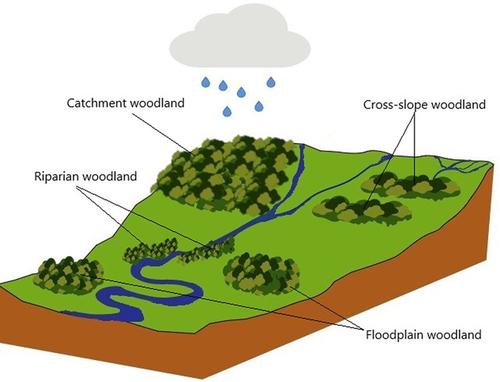当前位置:
X-MOL 学术
›
WIREs Water
›
论文详情
Our official English website, www.x-mol.net, welcomes your feedback! (Note: you will need to create a separate account there.)
Role of forested land for natural flood management in the UK: A review
WIREs Water ( IF 8.2 ) Pub Date : 2021-06-07 , DOI: 10.1002/wat2.1541 Matt M. D. Cooper 1 , Sopan D. Patil 1 , Thomas R. Nisbet 2 , Huw Thomas 2 , Andrew R. Smith 1 , Morag A. McDonald 1
WIREs Water ( IF 8.2 ) Pub Date : 2021-06-07 , DOI: 10.1002/wat2.1541 Matt M. D. Cooper 1 , Sopan D. Patil 1 , Thomas R. Nisbet 2 , Huw Thomas 2 , Andrew R. Smith 1 , Morag A. McDonald 1
Affiliation

|
Natural flood management (NFM) is the use of natural processes and environments to mitigate flood risk by reducing and delaying peak flood. This review introduces the concept and history of NFM and looks at the current state of research into the potential for using different types of woodland to fulfill the aims of NFM. Four woodland types (catchment, cross-slope, floodplain, and riparian) are discussed with reference to studies carried out, mainly in the United Kingdom, to determine the relative merits of each type and their effectiveness in mitigating flood risk. We then discuss how trees interact with the hydrological cycle, along with a discussion of modeling methods which seek to determine the amount of water intercepted by different types of forest cover. We find that while there is some evidence that carefully planned and managed woodland can mitigate flood risk, the published data for this evidence base is somewhat sparse. This may be either due to the long timescales needed for comprehensive studies or the relative infancy of the research on NFM. More research needs to be carried out in each of the four woodland types, especially in the UK, as policy makers are increasingly looking towards nature based solutions to mitigate the potential impacts of climate change. The concept of a combined canopy/hydrological model which can be scaled from stand to watershed level and incorporate different types of woodland is suggested as it would be beneficial in guiding woodland creation policy in the future, both at the local and regional scales.
中文翻译:

林地在英国自然洪水管理中的作用:综述
自然洪水管理 (NFM) 是利用自然过程和环境通过减少和延迟洪水高峰来减轻洪水风险。本综述介绍了 NFM 的概念和历史,并着眼于利用不同类型林地实现 NFM 目标的潜力的研究现状。参考主要在英国开展的研究,讨论了四种林地类型(集水区、跨坡、洪泛区和河岸),以确定每种类型的相对优点及其在减轻洪水风险方面的有效性。然后,我们讨论树木如何与水文循环相互作用,同时讨论旨在确定不同类型森林覆盖截获的水量的建模方法。我们发现,虽然有一些证据表明精心规划和管理的林地可以减轻洪水风险,但该证据库的已发布数据有些稀少。这可能是由于综合研究需要很长的时间尺度,也可能是由于 NFM 研究还处于起步阶段。需要对四种林地类型中的每一种进行更多研究,尤其是在英国,因为政策制定者越来越多地寻求基于自然的解决方案来减轻气候变化的潜在影响。提出了可以从林分到流域级别并包含不同类型林地的组合冠层/水文模型的概念,因为这将有利于指导未来在地方和区域尺度上的林地创建政策。该证据库的已发布数据有些稀少。这可能是由于综合研究需要很长的时间尺度,也可能是由于 NFM 研究还处于起步阶段。需要对四种林地类型中的每一种进行更多研究,尤其是在英国,因为政策制定者越来越多地寻求基于自然的解决方案来减轻气候变化的潜在影响。提出了可以从林分到流域级别并包含不同类型林地的组合冠层/水文模型的概念,因为这将有利于指导未来在地方和区域尺度上的林地创建政策。该证据库的已发布数据有些稀少。这可能是由于综合研究需要很长的时间尺度,也可能是由于 NFM 研究还处于起步阶段。需要对四种林地类型中的每一种进行更多研究,尤其是在英国,因为政策制定者越来越多地寻求基于自然的解决方案来减轻气候变化的潜在影响。提出了可以从林分到流域级别并包含不同类型林地的组合冠层/水文模型的概念,因为这将有利于指导未来在地方和区域尺度上的林地创建政策。需要对四种林地类型中的每一种进行更多研究,尤其是在英国,因为政策制定者越来越多地寻求基于自然的解决方案来减轻气候变化的潜在影响。提出了可以从林分到流域级别并包含不同类型林地的组合冠层/水文模型的概念,因为这将有利于指导未来在地方和区域尺度上的林地创建政策。需要对四种林地类型中的每一种进行更多研究,尤其是在英国,因为政策制定者越来越多地寻求基于自然的解决方案来减轻气候变化的潜在影响。提出了可以从林分到流域级别并包含不同类型林地的组合冠层/水文模型的概念,因为这将有利于指导未来在地方和区域尺度上的林地创建政策。
更新日期:2021-08-05
中文翻译:

林地在英国自然洪水管理中的作用:综述
自然洪水管理 (NFM) 是利用自然过程和环境通过减少和延迟洪水高峰来减轻洪水风险。本综述介绍了 NFM 的概念和历史,并着眼于利用不同类型林地实现 NFM 目标的潜力的研究现状。参考主要在英国开展的研究,讨论了四种林地类型(集水区、跨坡、洪泛区和河岸),以确定每种类型的相对优点及其在减轻洪水风险方面的有效性。然后,我们讨论树木如何与水文循环相互作用,同时讨论旨在确定不同类型森林覆盖截获的水量的建模方法。我们发现,虽然有一些证据表明精心规划和管理的林地可以减轻洪水风险,但该证据库的已发布数据有些稀少。这可能是由于综合研究需要很长的时间尺度,也可能是由于 NFM 研究还处于起步阶段。需要对四种林地类型中的每一种进行更多研究,尤其是在英国,因为政策制定者越来越多地寻求基于自然的解决方案来减轻气候变化的潜在影响。提出了可以从林分到流域级别并包含不同类型林地的组合冠层/水文模型的概念,因为这将有利于指导未来在地方和区域尺度上的林地创建政策。该证据库的已发布数据有些稀少。这可能是由于综合研究需要很长的时间尺度,也可能是由于 NFM 研究还处于起步阶段。需要对四种林地类型中的每一种进行更多研究,尤其是在英国,因为政策制定者越来越多地寻求基于自然的解决方案来减轻气候变化的潜在影响。提出了可以从林分到流域级别并包含不同类型林地的组合冠层/水文模型的概念,因为这将有利于指导未来在地方和区域尺度上的林地创建政策。该证据库的已发布数据有些稀少。这可能是由于综合研究需要很长的时间尺度,也可能是由于 NFM 研究还处于起步阶段。需要对四种林地类型中的每一种进行更多研究,尤其是在英国,因为政策制定者越来越多地寻求基于自然的解决方案来减轻气候变化的潜在影响。提出了可以从林分到流域级别并包含不同类型林地的组合冠层/水文模型的概念,因为这将有利于指导未来在地方和区域尺度上的林地创建政策。需要对四种林地类型中的每一种进行更多研究,尤其是在英国,因为政策制定者越来越多地寻求基于自然的解决方案来减轻气候变化的潜在影响。提出了可以从林分到流域级别并包含不同类型林地的组合冠层/水文模型的概念,因为这将有利于指导未来在地方和区域尺度上的林地创建政策。需要对四种林地类型中的每一种进行更多研究,尤其是在英国,因为政策制定者越来越多地寻求基于自然的解决方案来减轻气候变化的潜在影响。提出了可以从林分到流域级别并包含不同类型林地的组合冠层/水文模型的概念,因为这将有利于指导未来在地方和区域尺度上的林地创建政策。


























 京公网安备 11010802027423号
京公网安备 11010802027423号